Masters of Development Practice students share their thoughts on a Mexican landscape that is vastly diverse, while its history, governance, and political situation are deeply complex.
~Written by MDP students: Juhi Shah, Margot Whittington, Mandie Yantha
The University of Waterloo’s School of Environment, Enterprise and Development (SEED) organizes a field trip every year for the Master’s in Development Practice students, as a part of their curriculum with a goal of helping students gain practical learning experience in a developing country. This year, the program chose Mexico as the destination, allowing students to gain exposure to Mexican community-level sustainability initiatives as part of our learning process, given that the various challenges development practitioners encounter are better understood through experience on ground.
The focus of the field trip was to look at the development from a sustainability lens. The trip was designed to expose students to the daily complexity of the human-environment ecosystem in a developing country. Students were challenged to reflect on the idea of development and what it means in the context of sustainable development in the 21st century.
The field trip was very insightful given that we visited a new sustainable initiative every day. In addition to the educational visits, we experienced local culture by visiting local cafes and restaurants owned by native Mexicans, which broadened our understanding of Mexican culture, cuisine, and traditions. The visits to sustainable farms, co-operatives, and initiatives helped us understand the importance of community engagement as a critical part of development practice.
The trip allowed us to see the practical implementation of the concepts and theories we learned in our classes in action. The sustainability concepts and theories that we learned in class were also reflected in our learning on the trip. The field trip focused on observing how human-environment ecosystems interact to create societal and ecological outcomes. The trip helped us focus on development questions through the sustainable living lens and was structured around learning phases and development and utilization of capacities.
In this article we will share some of the insights we learned at the various ecological farms, co-operatives, and initiatives we visited during our ten days in Mexico in February 2020. Our group included students from countries all over the world, including Egypt, India, Bangladesh, Canada, China, Azerbaijan, Somalia, and Colombia. On our first day in Xalapa, our guide asked what came to mind when we thought of Mexico. For most, the answer was beaches and resorts. Evidently, prior to our trip, most of us had very little understanding of Mexico’s geographical diversity and political and historical complexities, not to mention the deep-rooted corruption and injustices that pervade the daily lives of Mexican citizens. We quickly learned that not only does Mexico have a growing agro-ecology movement, but also has a number of activists risking their lives every day to fight to protect their land and their environment.
Rancho Acayali Agroecológico
On one of our first days in Mexico, we took the city bus to the colourful town of Colonia Ursulo Galvan, Xico in central Veracruz, to meet Paul, a local farmer who runs Rancho Acayali. Once off the bus we walked a short distance past many colourful homes and a Mexican cowboy riding a horse down the street against a lush, green, and mountainous background. Paul’s home, also known as Rancho Acayali, was covered in plants and flowers, making the structure barely visible except for the vintage van parked out front. As we walked down the stairs to enter the property, we were delighted by the sight of various trees, plants, fruits, and vegetables of various colours and sizes, and many species unknown to us. We could hear the Tlanyahualapa stream in the background, that runs through the property, which sits on one and a quarter hectare of land.
Paul explained that he came to Mexico two decades ago after graduating from university in England and never left. Inspired by a growing permaculture movement, he has created a sustainable farm using organic and native seeds for self-consumption and for sale. Paul lives and works on the sustainable farm that he maintains and operates himself, selling his crops and coffee at the Coatl Bioregional Market, in Coatepec, Veracruz (which we also visited). On-site he has a compostable toilet, a woodstove, solar panels for electricity, homemade furniture, and handmade compost for his farm. Paul passionately explained to us how he uses the intercropping milpa system, used by the Mayans with his vegetables in rotation in the open field. He showed us around, pointing out each plant variety, explaining what each one is and its uses, and why each crop is important for both consumption and agriculture.
Paul grows garlic, cactus, vegetables, fruits, spices, and has an edible forest and diversified coffee plantations. He challenged us to identify various crops, but sadly many of us were not able to recognize some of our favourite foods in his garden bed. Paul explained that when he began growing traditional crops many locals commented that they had never seen or knew of them. Many of the crops sold at traditional markets are staple foods that are typically exported.
Interestingly, Mexico provides North America with a variety of crops such as avocados, mango, tomatoes, banana’s, and coffee only to name a few. Many farmers do not have the ability or knowledge to grow traditional crops, something that Paul hopes to help change. Paul has a large seed bank with over 100 seeds varieties and conducts training for schools, groups, and individuals to introduce or deepen permaculture knowledge. After our extraordinary tour, Paul and his partner were kind enough to share snacks of homemade wine, cheese, and spreads, which we quickly devoured. We were all very impressed with the large farm that Paul tends to himself and his passion to live sustainably off the land. Many of us jumped at the chance to take a tour of where he ferments, bottles, and packages his tea, coffee, and spices. I bought coffee grown by Paul and it has been a splendid part of my mornings, one of the best coffees I've ever had.
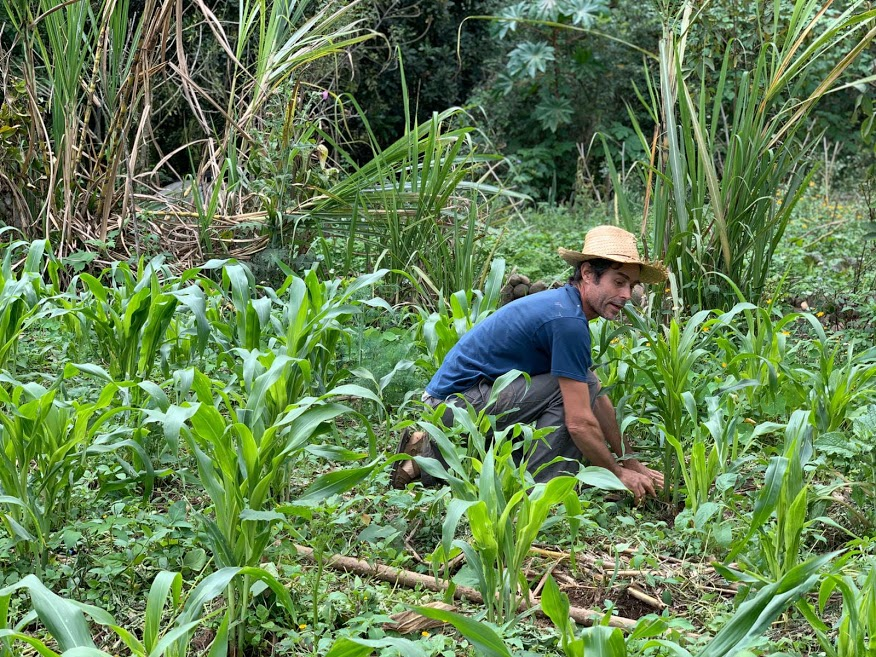
Paul explaining his farming techniques at Rancho Acayali Agroecológico
Rancho Agrosol, Coatepec
To get to Agrosol co-operative farm, you have to drive through a low river that runs all the way to the Gulf of Mexico. Along the way you drive by fields with horses and goats or “las cabras”. Agrosol is a farm co-operative that was created over 30 years ago by a German man named Jürgen Gläser. The farm operates on 17 hectares of land and is completely sustainable. After feeding us a delicious homemade lunch of beans, rice, tortillas, chayote, and salad, Jürgen gave us a lesson about sustainability while we drank delicious coffee grown and roasted on the farm. The “co-op” aspect of the farm refers to the fact that everyone who lives on the farm works and participates in the upkeep and maintenance of the farm, getting paid in return with free shelter and meals. The farm employs 20-25 interns who spend a year or two gaining farming knowledge and skills specific to biodynamic farming practices. Jürgen claims that spending a year on the farm is important because it takes time to change people’s mindsets about sustainability.
The farm’s training focuses on biodynamic practices, teaching students how to sustainably balance livestock growth and crop cultivation. The farm also implements various sustainability initiatives including the use of composting toilets, feeding food scraps to livestock, and recycling water using a small dam. We saw giant pigs feasting on taro (not for human consumption we learned quickly, as one classmate leaned in for a bite). We also saw the farm’s piglets, cats, and goats (and got to hold the goat babies – the one I held really took to me and fell asleep in my arms, much to his mother’s dislike!). Following that, we went on an adventurous hike, which was very steep going downhill and included an area where we had to be quiet around the beehives so as not to disturb the bees.
Along the way, we learned that Agrosol employs polyculture techniques, which involve planting multiple crops in the same area in order to enrich the soil, and growing plants that are suitable to the local conditions. We saw areas where banana plants drop their leaves and fertilize the soil for the coffee bean plants, a process known as cover crops and grazing. We also got to see where the coffee is harvested and roasted, and the greenhouse where flowers and vegetables are grown in cooler months. Agrosol aims to teach people how to use the land to be self-sufficient and simultaneously eco-friendly. We loved Agrosol for their sustainable mentality and initiatives and the beautiful land and animals, not to mention the delicious meal and freshly roasted coffee!
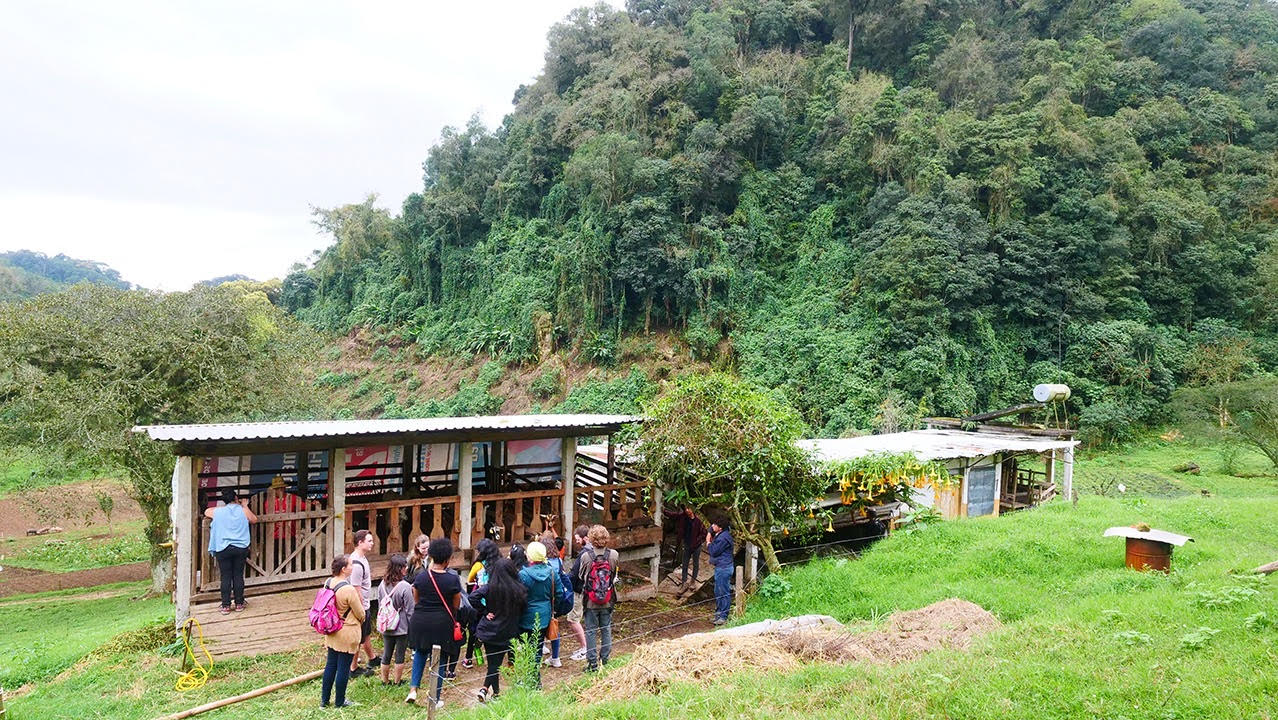
Visiting the Goats (Las Cabras) at Rancho Agrosol
Local Bar Talk with Land Defenders
To immerse ourselves into the local culture, one evening, a few of us went to a local establishment in Xalapa to listen to local music and drink Pulque, a traditional fermented drink made from the sap of agave plants. We were pleasantly surprised that we had stumbled upon a gathering of land defenders from across Mexico, holding a special knowledge sharing event. The place was alive with conversation, groups introducing themselves, and friends reunited in a common cause – to protect the Earth. Our eyes were glued to the makeshift stage where community members from Cherán explained to the diverse crowd how they successfully expelled the mayor, narcos (drug cartel) and police from their town. They explained how they created their own armies to protect their citizens and land from violence and the logging industry that was draining the nearby forests. The Cherán liberation is one of the best examples of a Mexican town liberated from violence, political parties, and narcos while creating their own political system based on traditional governance systems.
There is a growing trend of towns paving their own independence without political parties and identifying as an Indigenous town with the ability to self-organize. Checkpoints and rules are used to monitor who is allowed in and out of the area and to monitor the activity of industry and the government. Our group experienced a checkpoint in the town of Jalcomulco on our way to Los Pescados River. There was a camp set up a few years ago by the group Centinelas del Rio, defending against a large-scale dam project by the engineering and contracting company Odebrecht. Our driver had a short conversation with the group to explain who we were and provided a monetary donation for food for the group. Centinelas del Rio approached the stage to explain their community's challenges with a dam project that threatened to flood their community and 30 others living along La Antigua basin, the heart and soul of the communities. While they spoke, our Mexican guide’s eyes lit up, as he explained to us that the group speaking are his idols. The group is a highly respected and well-known group of land defenders that organize protest and wrote a book about their experiences. After the event, many people stayed to mingled with the other groups to share stories and experiences.
As we made our way to leave, one of the rooms we walked through had a projected video on the wall with a memory video dedicated to an environmentalist that was recently killed. On our walk home we excitedly talked about what we had witnessed. A diverse group of people brought together to share their experiences, successes, and challenges of protecting the land, their culture, livelihoods, and collective identities. This was a recurring theme of the trip; we met numerous individuals and communities taking environmental issues into their own hands by implementing community initiatives. It was very powerful to see the challenges many communities face and the brave actions and initiatives they have created to ensure future generations are able to have access to the land, water and traditional activates that depend upon the mother nature.
La Gloria
Getting to La Gloria involved a long and twisty uphill drive through a small town of decrepit homes, stray dogs, and children playing soccer in the streets. When we arrived, we walked past a small brick school towards an empty plot of grass on a hill overlooking the mountains and towns below. We were told we would be planting trees to offset our carbon offset for our trip. The trip organizers – a young couple from Xalapa who had studied our program a few years prior at the University of Waterloo – had calculated our carbon footprint including our flights and our car travel for the trip, and figured we needed to plant 50 trees to offset all the carbon we would be using during the trip. We got into small groups and began to dig with our hands and shovels. We planted food trees – Zapote blanco y Negro, Macadamia, Mango, and others fruit trees – so the trees could provide food to the children attending the school nearby. The cost of the trees was factored into the cost of our trip and amounted to 50 pesos per tree – 20 for the tree itself, and 30 for the maintenance of the tree. We planted 20 trees ourselves, and the rest were planted later by Pedro, the tree nursery owner, and his workers.
Pedro has been harvesting plants since birth. He began with coffee and figured out how to grow other species through observation. He is a self-taught farmer who also owns a rescue hive of stingless bees and two tree nurseries with over 100 species, compared to the government nurseries, which only contain five species. Pedro enriches his soil with construction waste – a great sustainable solution!
Pedro’s house was small and sparsely furnished. We sat in the small front room while we ate the delicious meal Pedro’s wife cooked for us, consisting of handmade flattened tortillas, salsa, chayote, vegetables, and tomales. The flavours were so fresh and authentic. It was my favourite meal of our entire trip. When I asked how long it had taken to prepare the meal, our guide led me to the kitchen at the back of the small house, passing a tiny bedroom on the way with one large bed and a few children’s drawings on the walls. Pedro’s wife, another female family member, and his two small children were there in the kitchen, standing by the wooden stove. The answer was four hours.
Our guide informed us that when he met Pedro a few years ago, his family couldn’t afford a second pair of shoes for the children to wear to school. Today, Pedro sells his trees and has improved his family’s quality of living. Pedro has stopped growing coffee because he doesn’t have enough time, but his dad and brother are a part of a coffee cooperative called FemCafe. We were lucky to be able to taste and purchase their delicious coffee while standing below their coffee trees! FemCafe focuses on four pillars: food sovereignty, economic justice, gender justice, and environmental justice. They grow agro-organic coffee and employ over 400 families in four municipalities in Veracruz, including many Indigenous peoples. Seventy percent of FemCafe’s sales go directly to the female head of house, as opposed to the husbands, in order to ensure that women and children in these families directly receive the money they earn and spend it according to their needs. While many farms in Mexico grow sun coffee, Pedro and his family have focused on growing shade coffee because it is more respectful of the nature in place. The mixture of various plants used in growing shade coffee is key to preventing soil erosion and increasing production of the soil. Additionally, a fungus called coffee rust does not grow in shade coffee.
We were promised that Pedro would care for our trees as if they were his sons. As we drove away from La Gloria, a light rain began to fall, nourishing the newly planted seedlings. As I sit at home, sipping my delicious FemCafe coffee, I hope the trees are growing strong so they can one day feed Pedro and his family and the school children nearby.
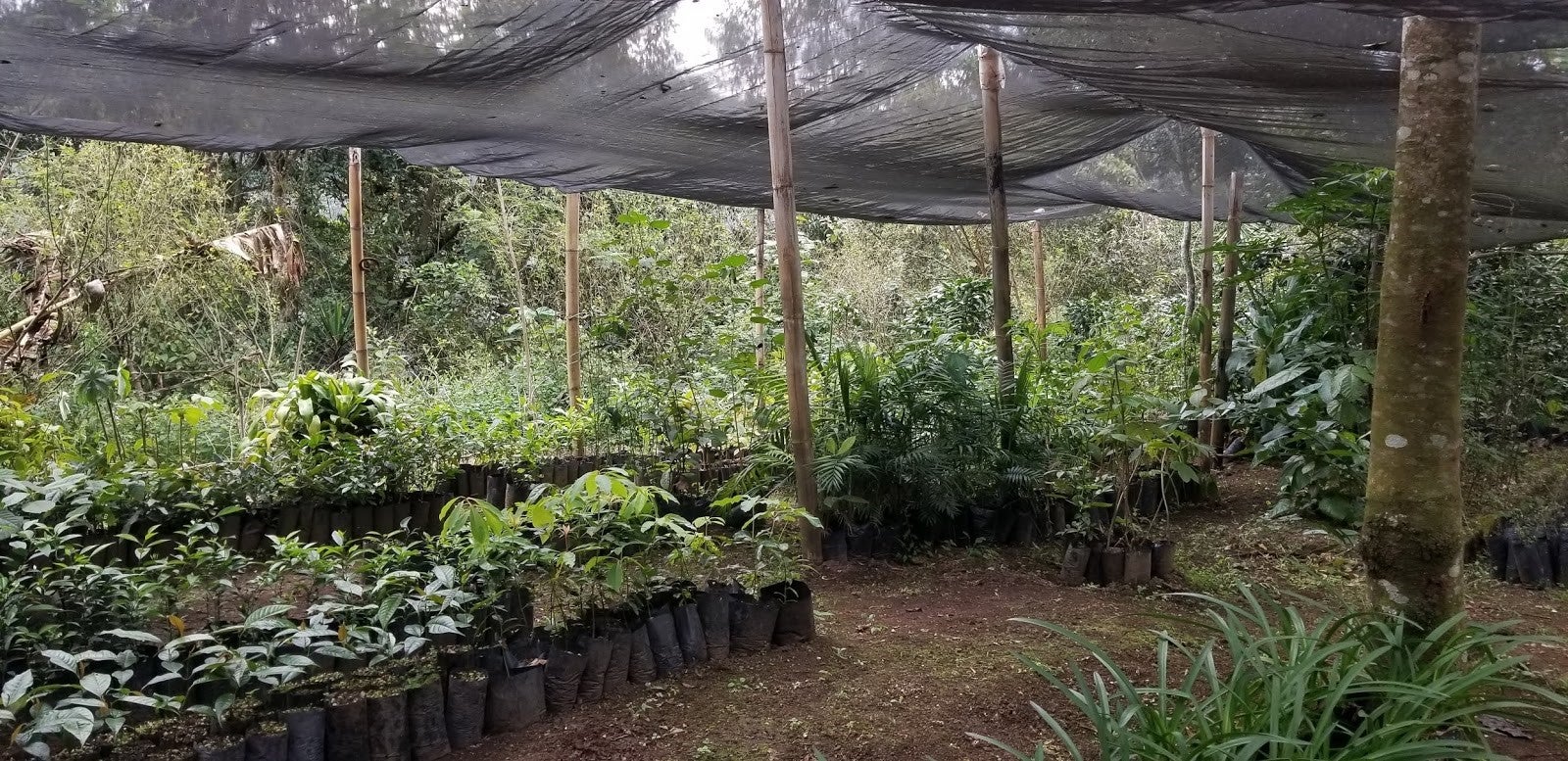
One of Pedro’s Tree Nurseries
Las Cañadas
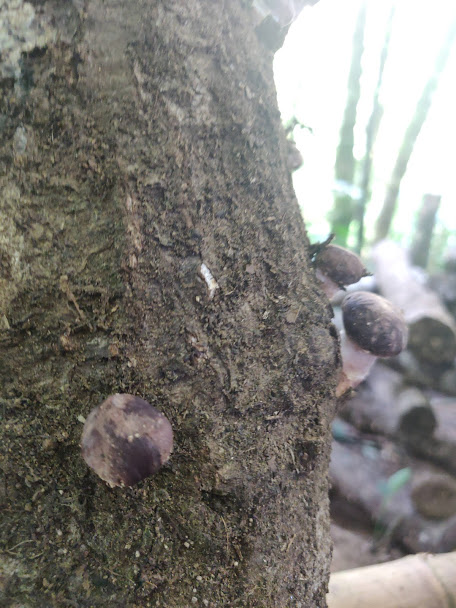
Getting to Las Cañadas was a long journey with beautiful scenery as we went up the hills. As we got off the bus, we could see vintage artistic infrastructure around us, beautiful lush green plants and trees and tip of Pico de Orizaba, Veracruz’s highest volcano, just like a painting. Las Cañadas is an agro-ecological centre and Permaculture, where it has found one of the last islands of the Cloud Forest from the central zone of Veracruz. Our local guides worked and lived in Las Cañadas. Having the opportunity to visit the co-operative with them and talking about the sustainable activities that they do on a daily basis was a big learning curve for all of us. While at the co-operative we roamed around the property to observe different sustainable initiatives performed. The first thing that caught out eyes was the fact that the co-operative has zero waste.
This was achieved by turning not only animal manure into fertilizers but also human manure through compostable toilets. The co-operative is self-sufficient as they produce most of their food, firewood for cooking, wood for building houses on their land. The purpose of the co-operative is also to develop creative solutions for environmental and social problems and adapt to the era of energy decline and climate change. Having said that, we observed some of the Eco technologies developed by co-operative for example Bicimanquinas (bike machine), solar water pump, wood saving stove and oven, homemade compost bin, tire ladders, rainwater harvesting and many other Eco technologies. In addition, it uses wood logs to cultivate mushrooms as part of their sustainable forest management practices. The co-operative houses approximately 20 families and has a functional school within its premises, where they teach students how to become self-sufficient through sustainable practices. The co-operative also has a store, which sells sustainable wood, self-made seeds, cotton t-shirts, books and manuals on sustainable living practices. While on our tour around the co-operative we came across the bees, which are crucial for carrying the process of pollination, are also conserved. Lastly, as one of our local guides mentioned, they were trying to build compostable toilets and other technologies for the uphill village residents to protect the water source from being polluted. While leaving from Las Canadas we took notes on how we will preserve and care about the environment and resources around us.
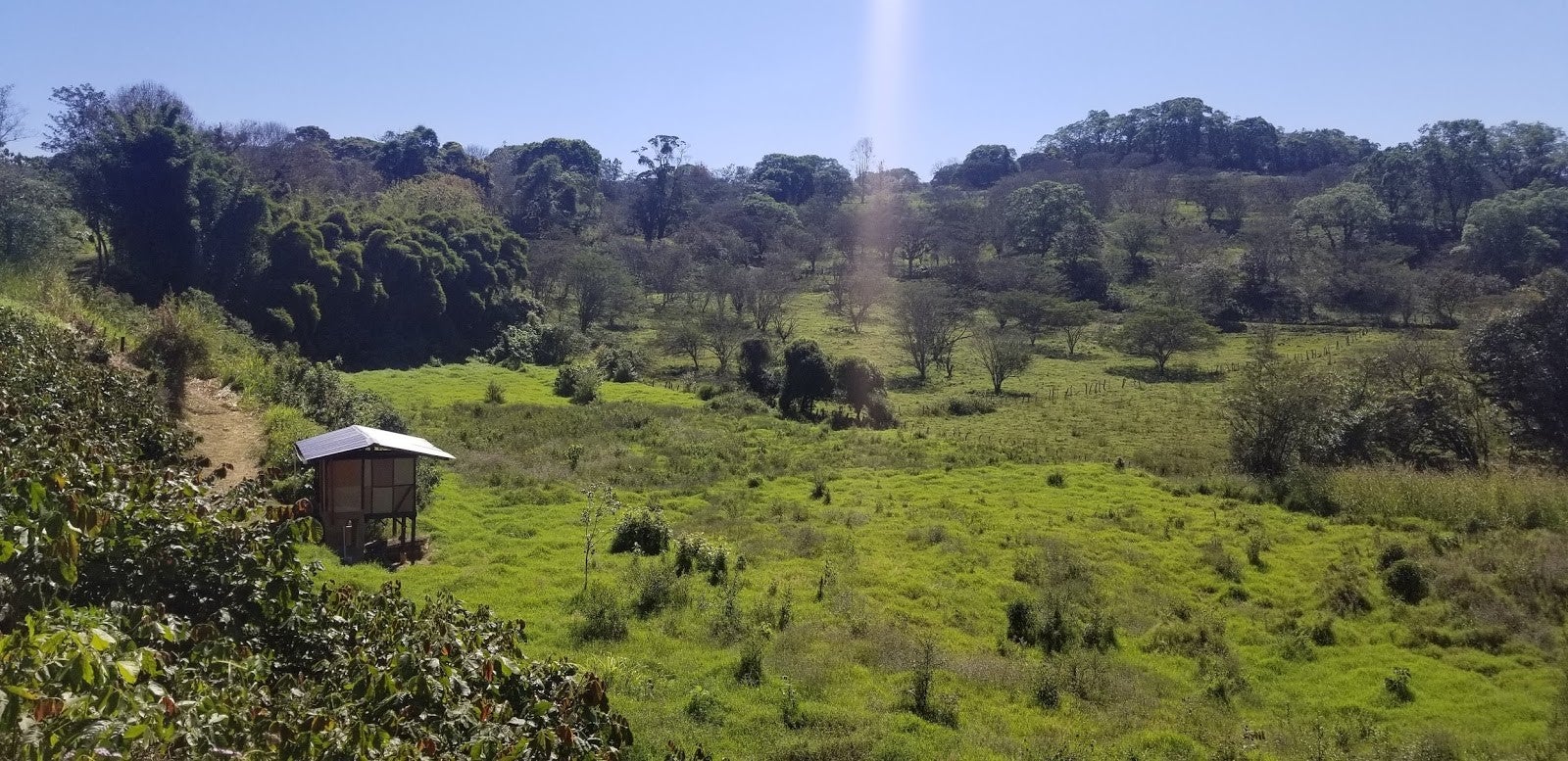
View of Los Canadas
La Mancha, Actopan
While on our trip to Mexico, we visited La Mancha in Veracruz State. La Mancha was a long ride, as it was far from where we were staying in Xalapa and so we stayed at the place overnight. Finally, near a beach in Mexico, the place looked mesmerizing as we saw the sunset. La Mancha is located in the coastal plains of the Gulf of Mexico. The place is uniquely located between ocean and mountains, where the Atlantic Ocean meets the lake and is the third most biodiverse area in Mexico. The area is particularly known for North American and Alaskan migratory birds.
The La Mancha Ecotourism project was started in order to protect the region from being taken over by Canadian gold mining companies. Most of the infrastructure has been built from biodegradable materials. The site creates temporary jobs and employs the local community members, who are mostly farmers, fishermen and cattle ranchers. For most of us, the talk we had with Adán Vez Lira, who was the leader of the project, was eye opening. Having listened to him so passionately protect the land motivated us to take action as and where we could.
He spoke about how the mining countries pose a threat to the biodiversity, wetlands and different ecosystems present in the area. Along with the community members of the region and various academia, Adán has researched and proven that the existing biodiversity will be majorly affected if an open pit mine were to be set up in the region. However, the mining companies have done their own research and falsely mentioned that the region is a dead zone with no biodiversity and thus conducting mining activities would be harmless. Having visited the place and stayed there overnight, we could agree to the fact that the area is one of the most diverse and cultural places in Mexico. As Adán mentioned, there is a need for a fair, unbiased environmental impact assessment, which the academic community has undertaken to contest the false assessments supported by the government.
The community has tried every legal way to stop the mining companies to enter; however, the mining companies have already bribed their way into getting permits and approvals through the federal government, which has given full permission to a Canadian mining company to begin operation. The ecotourism project at La Mancha was created so that tourism could generate enough money for the government to realize the importance of the area.
Since the area is located on the bank of the Atlantic Ocean, if the mining process takes place, the first and most obvious impact will be water pollution, which will disrupt not only Mexico’s entire ecosystem, but also that of North America. Adán implored us to question why open pit mining is illegal in many countries, including Canada, yet Canadian mining companies are allowed to exploit a mineral rich, biodiverse region in Mexico. For international companies it is easy to relocate and close down their operations if anything goes wrong, whereas the community has this one place that they have known and lived for most parts of their lives. As Canadians, Adán urged us to raise these issues with the Canadian government for letting these mining companies actively do things that are illegal in Canada. Isn’t it important that we save these regions?
While we saw many incredible sustainability initiatives in Mexico, we were reminded daily of the severe injustice and corruption facing environmental and human rights activists across the country. We will not soon forget the country’s cruel brutality against those who are brave enough to speak out against corruption in Mexico. In April, we were devastated to learn that Adán Vez Lira had been killed on April 8th, while riding his motorcycle in Actopan, Veracruz. Adán is the country's third environmentalist that has been killed in 2020.
Earlier this year, Isaac Medardo Herrera Avilés and Raúl Hernández Romero – both connected to one of Mexico's largest butterfly reserves – were also murdered. They protected the monarch butterflies and land from illegal logging in the violent state of Michoacán. Amnesty International reported that in 2019 at least 12 land defenders were killed in Mexico and called for investigations into their death and to hold those responsible accountable. Amnesty International has also requested meetings with the President to discuss protection for human rights defenders and an end to corruption-a platform the President ran on during his election, their requests have been unanswered.
As the demand for minerals and timber grows, corruption from various groups continues to rise. The land and water that communities and animals are dependent on for food, livelihoods, and shelter is stolen. If those who are speaking out on environmental issues and injustice are being killed, who will defend Mother nature?
Conclusion:
When asked at the beginning of our trip what came to mind when they thought of Mexico, many people in our group responded that their first thought was beaches and resorts. By the end of our ten-day trip, everyone’s perspective had drastically changed. We learned that, in reality, Mexico’s landscape is vastly diverse, while its history, governance, and political situation are deeply complex.
We came to understand that corruption is deeply rooted in the governance structures in Mexico to the extent that the resulting injustices are evident in the daily lives of average citizens. Cars are pulled over for no reason by the police looking for a bribe, Indigenous land defenders face violence and police brutality, and environmental activists are murdered for speaking out against powerful corporate interests. You don’t realize how powerful your own voice is, until you see others have their voices silenced. We hope this article has enlightened readers to some of the injustices people in Mexico are facing as they fight to protect their land and their environment.
There is much, much more to Mexico than beaches and resorts, including mountains, volcanoes, and forests rich with biodiversity. Many farmers in Mexico are choosing polyculture practices over monoculture, to create more enriched, biodiverse agricultural landscapes. As we saw, many farmers are also working to protect native bee species and teaching others about biodynamic farming practices because they deeply care about their environment and want to farm according to principles that will better protect the earth. Yet, to be an environmental activist in Mexico is a dangerous and life-threatening path to take. These people are putting their lives at risk to protect their land and their biodiversity. The least we can do is to support them in their fight and share what they have taught us.
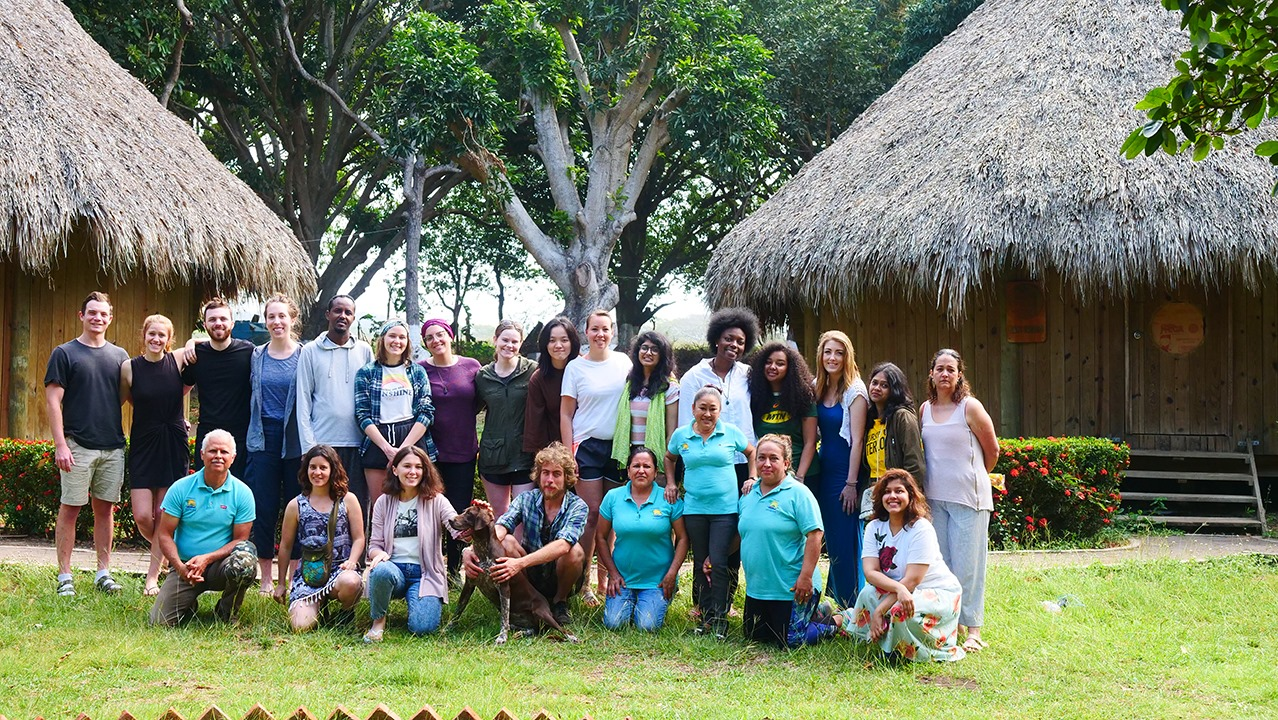
Photo by Gerardo Sanchez Vigil
Adán Vez Lira, La Mancha Staff & Students